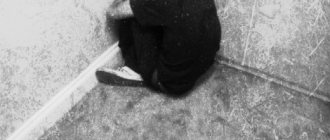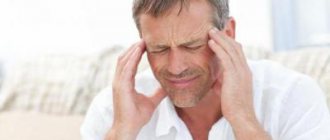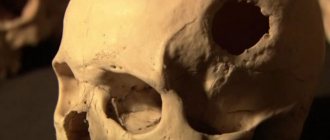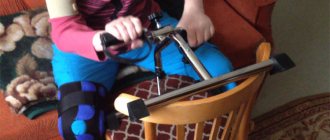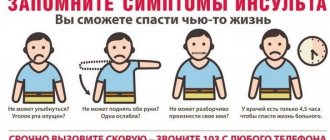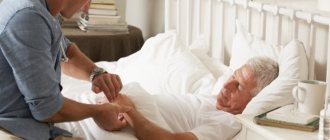Rehabilitation after stroke
Recovery or rehabilitation after a stroke is a set of measures aimed at returning the abilities and functions of the body lost due to impaired blood circulation in the brain. Rehabilitation after a hemorrhagic stroke, as after an ischemic one, requires the involvement of specialized specialists. This allows you to restore lost abilities with minimal functional impairment. To rehabilitate people who have suffered a stroke, a group of doctors specializing in this issue works at the New Hospital. Our rehabilitation center in Yekaterinburg helps patients get back on their feet and return to a full life.
How to learn to use a walker
As soon as the patient learns to stand confidently on his feet without support, he can begin to take his first steps. You can’t do this without an assistant, since he must belay from the paralyzed side to prevent a fall.
The patient should place the assistant's hand on the neck and rest his knee on the assistant's knee. Having fixed the joint, you can take the first step.
The assistant’s task is not only to support the patient, but also to control the correctness of his gait. When the patient moves with the help of a walker, it is necessary to ensure that the placement of the foot, rotation of the knee and hip joint are correct.
The whole process has several features:
- The patient cannot fully grasp the assistant's hand, since it is weakened.
- To take a step, he needs to throw his leg forward, which leads to the helper's leg catching.
- It is much more convenient to support the patient from a healthy part of the body, but the knee joint will not be fixed and the patient will not be able to hold on to the wall with his healthy hand.
The main purpose of using a walker is to gain the ability to bend the leg in all joints, otherwise the patient will constantly cling to the floor with his foot. The assistant should remind the person that the leg should be raised higher and bent at all joints.
High boots that fix the ankle joint will help facilitate movement. The affected arm should be secured with a scarf so that it does not sag during movement and the head of the humerus does not come out of the socket. During exercise, you should monitor the patient’s heart function and give him rest.
Once the patient can move with the help of a walker without assistance, he or she can begin to walk independently. This is done with the help of a cane, holding on to the walls, moving a chair in front of you. But it is important to ensure that the load is evenly distributed. You cannot spare the sore leg by relying more on the healthy one.
Symptoms
The term “stroke” in medical practice refers to a pathology in which there is a circulatory disorder in any part of the brain. After an attack, certain brain structures are damaged, causing the person to lose (partially or completely) certain skills. There are two types of this pathology:
- ischemic stroke - a circulatory disorder due to partial or complete blockage of a vessel;
- hemorrhagic stroke is a violation of the integrity of a vessel with subsequent hemorrhage in the brain.
Clinical manifestations of the pathology vary depending on which part of the brain was affected (left or right side, specific area), as well as the severity of the “impact” (the extent of damage to brain tissue). In most cases, rehabilitation after a hemorrhagic stroke is longer and more complex, since the nature of the lesions is more severe.
Exercises to restore walking skills
The number of repetitions will depend on the patient’s condition; if he cannot do some exercises, the patient can be helped. Excessive exercise is best done when the patient feels better.
- in a lying position with the knees bent, the patient straightens first one or the other leg, starting movements from the healthy limb,
- throwing one leg over the other alternately,
- the patient turns his feet inward and then to the sides,
- extension and flexion of the joints of the arms and legs,
- doing the “bicycle” exercise,
- abduction of the leg to the side: the exercise is performed lying on your back with your legs straightened or bent at the knees,
- pelvic lift: legs bent at the knees, in a lying position the patient raises and lowers the pelvis,
- moving the straight leg over the other,
- flexion of the legs,
- Lying on his side, the patient should raise and lower his leg, then, turning over to the other side, do the same with the second leg.
Restoring muscle control is not so easy, but the efforts made by the patient and his family sometimes achieve incredible results. There are many cases in medical practice when seemingly completely hopeless patients returned to their previous lives.
Stroke treatment
The promptness and correctness of treatment carried out after an attack directly affects the success and timing of rehabilitation, as well as life after a stroke in general. It doesn’t matter whether the stroke occurred on the left or right side, the type of pathology plays a role in treatment:
- Ischemic - all actions are aimed at restoring blood circulation and eliminating the causes of vascular obstruction. To do this, medications that thin the blood, dissolve blood clots are used, or non-invasive methods are used to destroy blood clots.
- Hemorrhagic - first of all, it is necessary to stop the hemorrhage with medication. The resulting blood clot is then surgically removed, and aspiration may be used.
Training order
In order for the patient’s rehabilitation to be effective, the tactics of physical therapy must be developed exclusively individually. Moreover, all exercises should be performed in strict sequence so that they are as physiological as possible.
The order of mastering the exercises is as follows:
- 1st group of exercises - in bed: turning over from side to side, pushing the body with your legs from the headboard, moving to a sitting position without lowering your legs from the bed, and returning to a lying position without falling.
- 2nd group of classes: strengthening the ability to sit independently on the bed, active gymnastics in a sitting position, learning the ability to lower the feet from the bed, then gradually standing up on the healthy leg.
- The 3rd group of exercises is done when the patient stands steadily on his healthy leg. It's time to get a walker.
- 4th group of exercises - in a standing position using a walker: carefully stepping from foot to foot.
- 5th group of exercises: the patient develops a stable gait using a walker. The load on the leg muscles increases, the distances the patient travels gradually increase, and the intensity of therapeutic exercises increases.
This is an ideal theoretical option. In practice, the process of verticalization of the patient is much more complicated, with frequent failures, interruptions, attacks of decadent mood and the return of faith in victory over one’s immobility.
About 90% of stroke patients remain disabled. It takes a lot of effort to restore normal brain activity. Rehabilitation takes a long time. It is carried out not only in the hospital, but also at home. Physical exercises after a stroke are aimed at restoring lost functions.
As a result of a stroke, a person experiences an acute cerebrovascular accident (ACVA). Cells in the lesion die and can no longer perform their functions. Stroke is one of the common causes of death after coronary heart disease. If stroke was noticed and treated in time, then the person has a chance to live, but dead brain cells are no longer restored.
Depending on the location of the lesion, the patient suffers from memory impairment, drowsiness, loss of orientation in space, and problems with speech. Special rehabilitation exercises after a stroke help improve the quality of life. It has the following effects on the body:
- prevents blood stagnation in paralyzed tissues;
- restores muscle memory;
- mobilizes the activity of intact neurons, which take on part of the functions of dead cells;
- restores the brain’s ability to send motor impulses to nerve endings;
- stimulates blood flow, thereby improving blood supply to the brain;
- prevents the development of recurrent stroke.
Comprehensive program “Rehabilitation+”
This stroke rehabilitation program aims to return patients to as full a life as possible.
The main task of the specialists at the “New Hospital” is a separate approach to each patient. We use maximum opportunities to restore lost skills:
- restoration of vision;
- motor activity (recovery of arms and rehabilitation of legs after a stroke, fine motor skills);
- speech restoration;
- learning to tie shoelaces, wash dishes, etc.;
- restoration of driving skills.
As part of the program, our specialists try to restore not only the basic skills that were lost. We try to return the patient to a full life, focusing on the tasks that are necessary for a specific person.
Getting up
When the patient learns to sit without any help, the rehabilitation process can be considered successful. The main task then becomes the development of this skill and long-term retention of the position. Therefore, it is necessary to teach him to remain sitting for a long time. To do this, you need to help the person sit down by lifting him by the arms.
If a person can already sit, then it is worth moving on to full-fledged exercises that will strengthen this skill. All of them are performed at home. The most effective of them:
- Head rotation. It is required to perform circular movements with the head, capturing several cervical vertebrae (up to 7) with it. Additionally, you should tilt it forward. The exercise is repeated up to 10 times.
- Holding a position. You need to sit on the bed and hold on to a hard, reliable surface with your hands, carefully arching your back. The exercise only takes a few seconds, but requires 10-15 repetitions.
- Lifting your feet off the floor. The patient should sit on the bed and raise his feet 40 cm so that they do not touch the floor surface. You need to hold this position for about 10 seconds. Repeat the exercise 10-20 times.
Additionally, you can alternately pull your legs towards your chest while lying on your back to prepare your joints for future stress. After completing all the therapeutic exercises, you should try to learn how to get up. It will be very difficult, but you will be able to achieve results if you try hard and believe in yourself. It is attempts to get up that are the main method of restoring walking after a stroke. There are 2 training options:
- Lifting. With the help of a rehabilitation therapist, the patient should rise slightly while remaining on the bed. Gradually the level of lift should be increased.
- Movements on the bed. The patient needs to sit on the edge of the bed, and then slowly move from the top to the bottom, moving his legs along the floor.
When you manage to stand up fully, you can move on to walking. The last stage will be the most difficult, so loved ones should show increased attention and care towards the sick person.
Rehabilitation plan
In our stroke recovery center, an individual rehabilitation plan is developed for each patient.
It takes into account the degree of brain damage, the patient’s age, type of stroke, etc. The best specialists are working to create a plan, studying in detail the medical history, the patient’s life, and recording lost abilities. Thus, after an ischemic stroke of the brain, rehabilitation can be radically different for 2, 3, 5 or more patients. This is explained by the fact that the characteristics of the lesion are different in each case and must be taken into account when creating a plan.
Restoration of motor functions
At the “New Hospital” in Yekaterinburg, rehabilitation specialists, neurologists and physical therapy doctors are involved in the restoration of motor functions. The tasks in this case are:
- stimulation of muscle activity;
- muscle strengthening;
- massage;
- stimulation of coordination between the brain and organs of the musculoskeletal system.
In this case, the main thing is to create a safe environment for the patient. To achieve the goal, special products for rehabilitation after a stroke are used (canes, walkers, exercise equipment, etc.).
What problems appear with gait?
After a stroke, walking causes many problems because motor function is impaired. This is not the only complication, but it is common.
The severity of the manifestation depends on the patient’s age, the degree of brain damage and the general condition of the body. Before restoring gait, it is useful to find out exactly what problems a person is experiencing after an attack.
Difficulty walking:
- Increased unsteadiness, which is not observed in a healthy person. It becomes difficult to maintain balance and not fall.
- It is difficult to straighten and bend the leg. Often the lower limb is in a straightened position and is difficult to control.
- A person begins to walk slowly because he is unable to move quickly. He feels insecure, and his steps become incorrect.
- Unable to fully stand on one foot. Because of this, a person begins to walk on his toes, and not on his heels, as is normal for healthy citizens.
- Sensitivity is significantly reduced, so every step can lead to a sudden fall.
Because of this, walking after a stroke is not easy for a person. You need to know exactly what to do, because only in this case will it be possible to achieve a positive result. The sooner you start training, the faster you will be able to recover from an injury.

